

The Impact of AI on Insurance: 18 Top Use Cases You Must Know






In 2025, artificial intelligence continues to transform the insurance industry, moving far beyond experimental adoption into core operations. From underwriting and claims management to fraud detection, customer support, and dynamic risk modeling, AI is creating faster, smarter, and more resilient processes.
Rising competition, evolving customer expectations, and increasing regulatory oversight are making AI-powered solutions indispensable for insurers looking to stay ahead. According to KPMG, 57% of insurance organizations view AI as the most important technology to achieve their ambitions over the next three years.
This blog highlights 18 top AI use cases in insurance, showcasing real-world applications and forward-looking innovations that define current market trends and reveal how the industry is preparing for the future.
AI in insurance refers to the use of artificial intelligence technologies like ML, NLP, and predictive analytics to automate, optimize, and enhance key insurance processes. These include underwriting, claims management, fraud detection, customer support, and personalized policy recommendations.
By analyzing vast amounts of structured and unstructured data, AI enables insurers to make faster, data-driven decisions, reduce risks, improve efficiency, and deliver tailored customer experiences while staying competitive in a digital-first market.
Generative AI is trending in insurance in 2025 because it’s enabling rapid innovation across the value chain. Market size jumped from $1.08 billion in 2024 to $1.5 billion in 2025.
Insurers are using GenAI to automate traditionally laborious tasks like claims documentation, policy drafting, and customer correspondence. It’s also helping with personalization, contextual policy offers, tailored risk profiles and improving speed and efficiency.
Regulatory pressure, cost containment, and demanding customers are pushing companies to adopt GenAI more aggressively, making it one of their top strategic priorities this year.
Generative AI is transforming insurance by automating routine tasks, enhancing risk detection, and improving customer interactions.
Beyond efficiency, it empowers insurers to deliver highly personalized services while lowering operational costs. Below are four practical and impactful use cases shaping the industry in 2025.
Large Language Models (LLMs) can quickly generate structured claims reports from unstructured inputs like emails, images, or handwritten notes. This reduces manual effort, accelerates claim settlement, and improves accuracy.
By standardizing documentation, insurers enhance efficiency while freeing adjusters to focus on complex cases requiring human judgment and expertise.
Generative AI produces synthetic datasets to train fraud detection systems without exposing sensitive customer information. These datasets capture rare or unusual patterns often missed in traditional models.
With richer training data, insurers strengthen anomaly detection, reduce false positives, and proactively address fraudulent claims, safeguarding revenue and customer trust.
Generative AI analyzes customer behavior, risk profiles, and financial needs to create tailored policy suggestions. Unlike generic offerings, these recommendations adapt dynamically to life events or changing circumstances.
The result is higher relevance, stronger customer satisfaction, and deeper loyalty enabling insurers to provide value-driven services that resonate with individual clients.
GenAI-powered chatbots deliver human-like conversations, offering round-the-clock support for claims, payments, and policy queries. These systems understand context, learn continuously, and adapt responses for personalized interactions.
Insurers benefit from reduced support costs, quicker response times, and improved customer experiences that meet rising expectations in an increasingly digital-first insurance landscape.
The transformative potential of AI is steering the insurance industry away from the age-old "detect and repair" approach towards an adaptive "predict and prevent" strategy.
These 18 real-world artificial intelligence insurance use cases vividly demonstrate this paradigm shift.
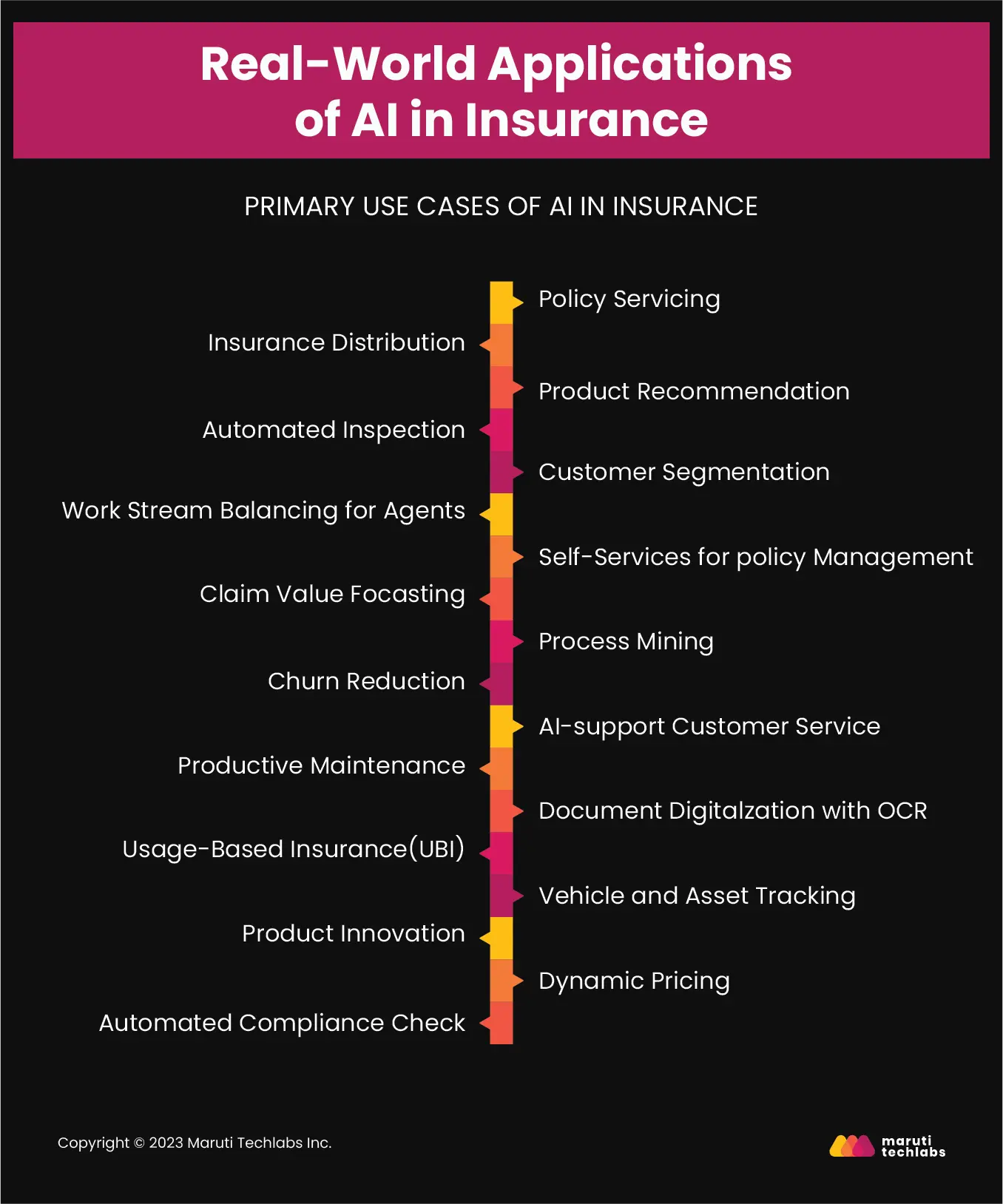
The most predominant complaint among insurance consumers revolves around issues tied to policy servicing. Policy servicing refers to a range of tasks and interactions after a policy is issued. For example - policy amendments, premium payments, claims processing, policy renewals, customer inquiries, and more.
Integrating AI into the policy management system can significantly optimize operational efficiency. It can expedite processes, reduce manual labor, enhance accuracy, and elevate the overall customer experience.
By leveraging RPA in insurance, companies can automate the most tedious administrative and transactional tasks, including accounting, settlements, risk assessment, credit control, tax preparation, and regulatory compliance.
One prime example of this is WorkFusion. WorkFusion blends AI and machine learning techniques to analyze various documents and facilitate the automated intake of policy data. This lessens the manual effort needed to discover the pertinent fields for policy endorsements.
Gone are the days when insurance distribution was a door-to-door sale.
Consumers are rapidly moving towards online platforms for insurance policy research, comparison, and informed decision-making. Forward-thinking insurtech companies are seizing this opportunity to revolutionize the insurance distribution phase.
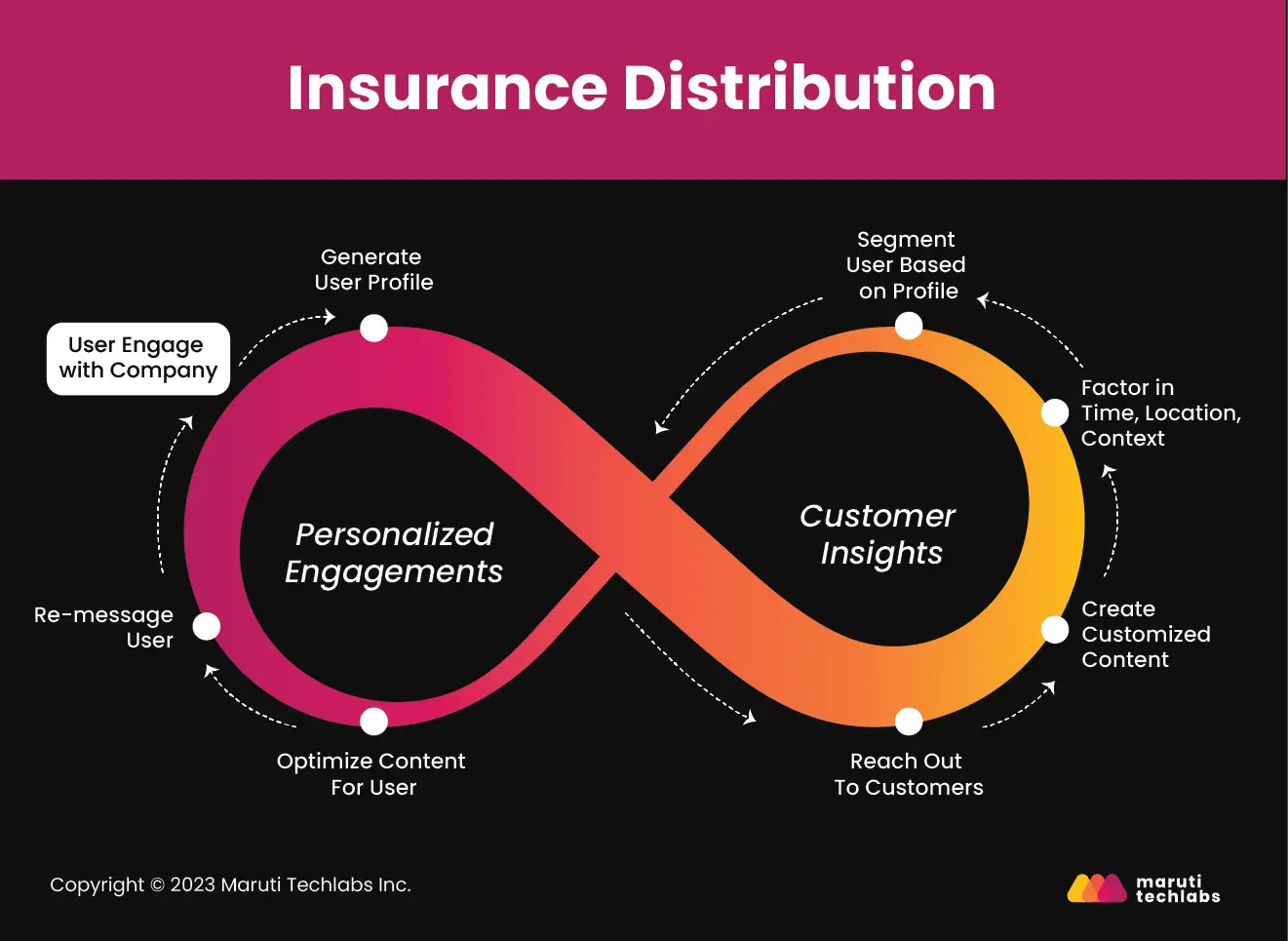
Modern insurtech companies are harnessing the power of optical character recognition (OCR), speech analytics, machine learning (ML), and natural language processing (NLP) to capture and capitalize on a customer's digital behavior.
Their digital behavior aids in facilitating data-driven personalization. AI can tailor the policy offers and reach out to potential customers through the most suitable insurance distribution channels at the most appropriate time, thus resulting in a significant increase in uptake, higher revenue, and a larger market share.
The ‘one-size-fits-all’ approach no longer attracts modern consumers.
This has pushed insurance companies to adopt personalized product creation and recommendations. Insurance companies leverage multiple data sources, like connected devices, wearables, speech recognition, and social media, to extract valuable insights.
By capturing and analyzing these data points, insurers can better understand customers' needs and preferences, which enables them to offer customized insurance offerings. This not only saves time and money but also instills confidence and loyalty.
Predictive machine learning models can significantly improve the accuracy and timeliness of these personalized recommendations. It's worth noting that data quality is a critical component in this process - the more detailed and accurate the data, the more accurate the predictions.

Sproutt Insurance, an insurtech company, leverages AI to offer tailored life insurance plans. They use an AI-powered assessment considering various variables like lifestyle, emotional health, and nutrition. Based on these insights, Sproutt recommends life insurance products aligning with an individual's needs. This innovative approach streamlines the insurance process and offers a highly personalized experience to customers.
Insurance assessments have relied on manual, costly, and time-consuming manual inspections. With AI-driven image processing and cognitive computing, insurers can swiftly and accurately examine car damages and provide detailed assessment reports. This not only reduces claim estimation expenses but also expedites the claims procedure.
AI also helps minimize human error and provides more reliable data for determining the final settlement amount. Companies like Liberty Mutual and CCC Intelligent Solutions are actively exploring AI-driven solutions to enhance the speed and accuracy of claim assessments.
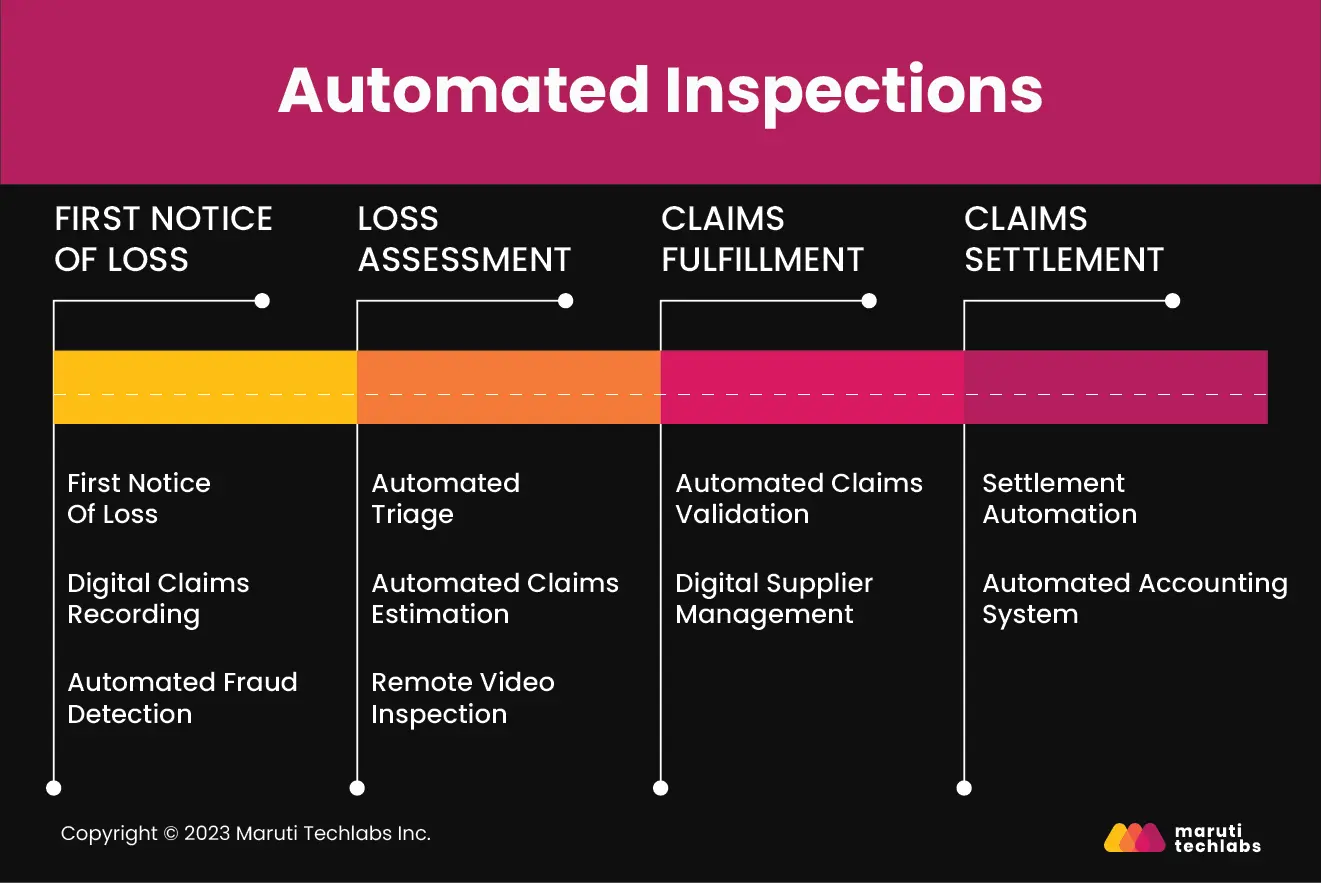
Customer segmentation is at the heart of personalization. With data-driven insights into policyholders, AI algorithms can categorize customers into specific segments based on their behaviors, demographics, and preferences. This enables insurance companies to tailor their products to optimize budgeting, product design, promotion, and marketing.
AI can also help identify high-value customers, predict their future needs, and recommend suitable policies, leading to more effective cross-selling and upselling strategies.
Furthermore, with machine learning models, insurers can continuously refine their segmentation, adapting to changing customer dynamics and ensuring their offerings remain relevant. Ultimately, AI-driven customer segmentation empowers insurance companies to deliver personalized services, improve customer satisfaction, and boost their bottom line.
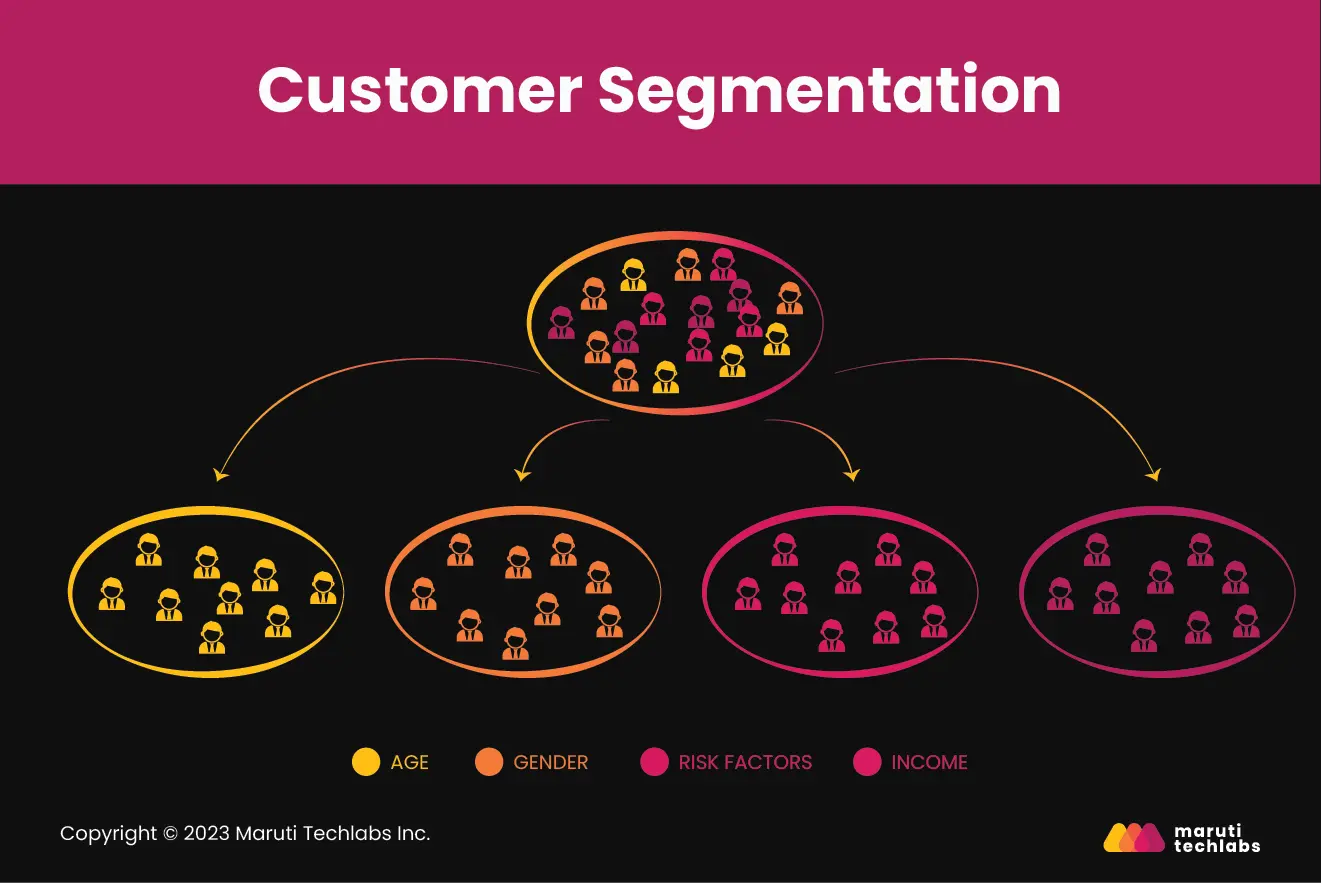
Insurify, an insurance aggregator, efficiently connects customers with car and home insurance companies tailored to their unique requirements. They leverage the RateRank algorithms to assess various factors, including a customer's location and the desired discount amount, to identify policies that align with their needs.
Incorporating AI into workstream balancing can significantly boost operational efficiency and customer satisfaction. Predictive modeling tools can accurately anticipate peak workloads and customer demands, enabling managers to align resources effectively.
AI can also monitor an agent's tasks and responsibilities in real-time, identify bottlenecks, redistribute work, and prevent delays in customer service. It intelligently assigns tasks based on the agent's skills, experience, and workload, thus ensuring an expert handles each task.
Nika Lee, Chief Underwriting Officer for Aioi Nissay Dowa UK, says, “Investigations are now closed faster, accompanied by reports and supporting evidence. In addition, there is enhanced ownership by claims handlers because they trust the solution due to its explainable nature and want to contribute to its improvement.”
While RPA facilitates the automation of repetitive tasks, AI bots free up an agent's time by handling repetitive queries. Machine learning tools help in customer segmentation, enabling agents to offer personalized services to targeted consumers.
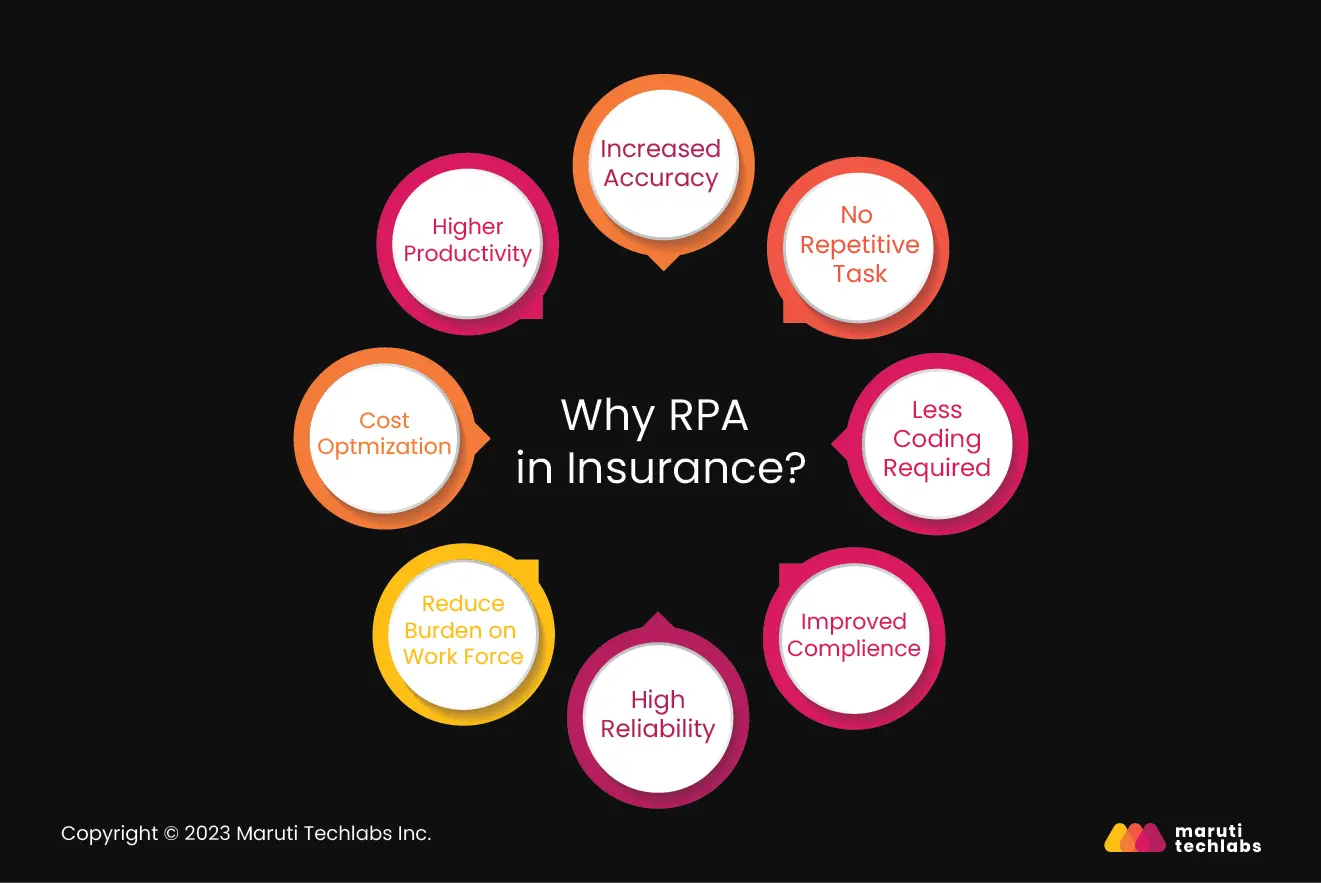
Maia, a virtual assistant, resulted in a notable acceleration of agent servicing and self-servicing. Maia was instrumental in reducing the average waiting time for users in live chat interactions by a significant 40%.
Most customers say, ‘attending sales calls for insurance policies is irksome’.
EY Insurance Industry Outlook 2021 reports stated that 69% of customers prefer to buy auto insurance online. AI-driven self-service platforms enable policyholders to manage and maintain their insurance policies independently. This includes tasks like policy renewals, updates to coverage, and claims processing.
AI-powered chatbots and virtual assistants provide real-time support, guiding policyholders through the process. They can assist policyholders in uploading the documents, determining their validity, and fast-forwarding the methods. Additionally, AI algorithms can proactively recommend policy adjustments based on changing circumstances, ensuring that policyholders are adequately covered while optimizing costs.
Sofya Pogreb, COO at Next Insurance, says, “The percentage of insurance applications that require human touch will go down dramatically, maybe 80% to 90%, and even to low single digits.”
Self-servicing with AI enhances customer satisfaction and reduces the administrative burden on insurance companies, leading to more efficient and cost-effective operations.
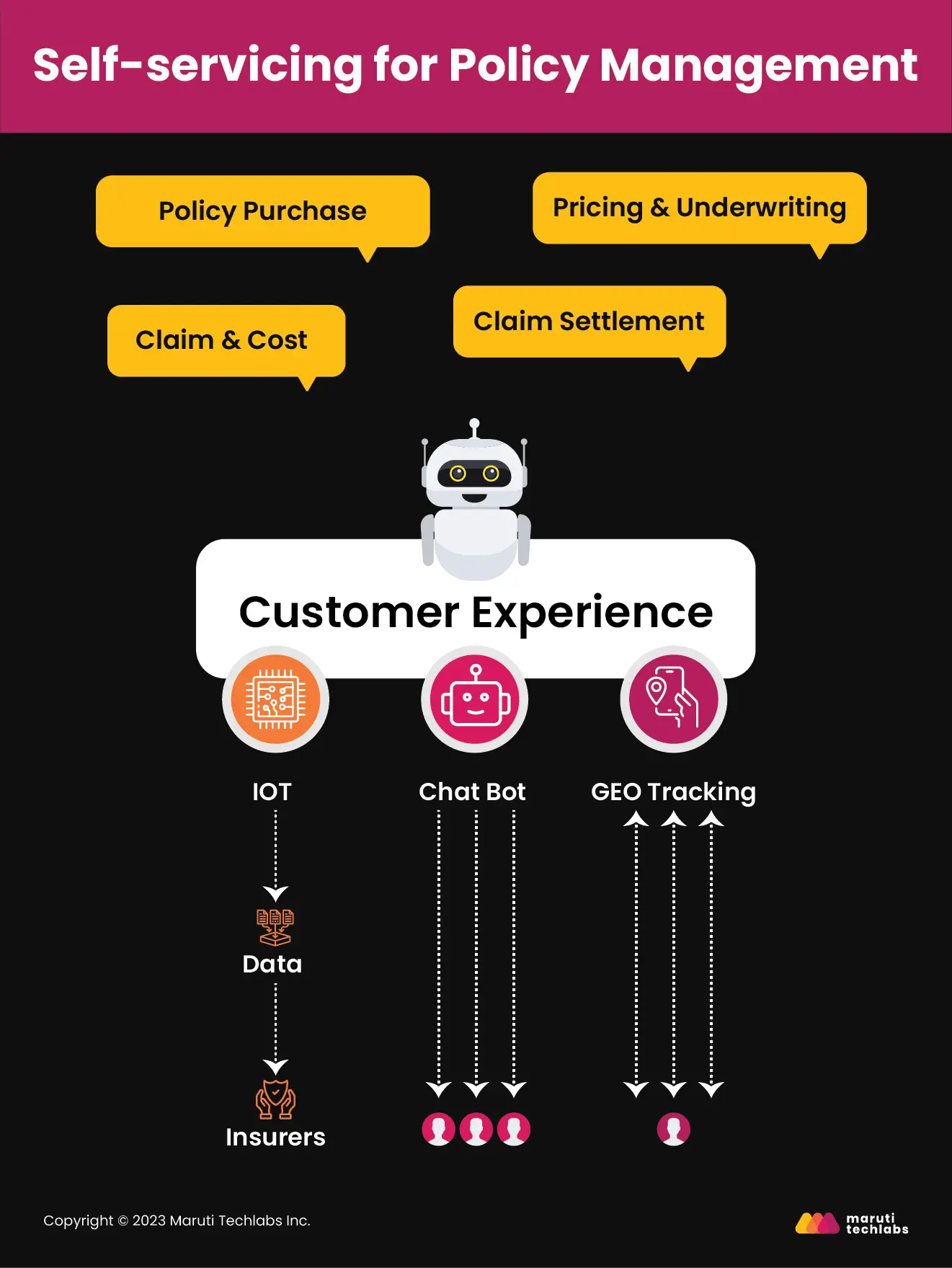
Inshur, an insurtech app, harnesses the power of AI to enable professional drivers to conveniently search and compare various insurance quotes and select a policy that aligns with their specific requirements. It further facilitates the seamless transfer of existing policies, streamlines the claims reporting process, and provides real-time alerts, enhancing the overall insurance experience for users.
Insurance claims value forecasting leverages AI tools to assess claim payouts accurately. AI considers various parameters like policy details, accident details, and claimant characteristics to estimate the likely value of a claim. This enhances claim processes, minimizes overpayment risk, prevents fraud, and boosts operational efficiency for fair, accurate, and consistent settlements, benefiting both insurers and policyholders.
As a result, insurance companies increasingly turn to AI-driven claim value forecasting to stay competitive and provide a superior customer experience.
“Outside of underwriting, sales, and customer support, perhaps the most exciting opportunities for AI in insurance are in the claims area.” - Robert Stewart, Head of Sales at the UK’s Claims Consortium Group.
Tokio Marine, an auto insurer, leverages an AI-based computer vision system and image recognition technology to assess damaged vehicles. This helps in reducing the time to process auto accident claims.
The insurance industry has complex and outdated processes that are both costly and difficult to change. Many organizations are stuck in these processes due to resistance to change. AI facilitates process mining that can help optimize workflows, cut down expenses, reduce processing time, and boost customer satisfaction and compliance.
AI scrutinizes extensive datasets to uncover patterns, bottlenecks, and inefficiencies in insurance processes like claim processing, underwriting, risk assessments, back office functions, and policy issuance. It helps streamline and optimize these processes, boosting efficiency and reducing processing times.
Furthermore, AI is pivotal in automating damage assessment, calculating claimant payouts, and identifying potential fraudulent claims. All of these contribute to a more suitable and accurate claim experience.
Churn reduction, even with marginal improvements, can yield substantial revenue gains, amounting to hundreds of thousands of dollars. Natural Language Processing (NLP) within the AI space enables the detection of customer sentiments in call transcripts. This helps identify discontented clients and boost proactive measures to prevent and reduce customer churn.
AI tools pinpoint pivotal factors driving customer attrition, including delayed claims processing, service dissatisfaction, or premium fluctuations. They provide timely warnings and recognize early indicators of possible churn, enabling insurers to engage in personalized retention strategies.
Furthermore, AI streamlines claims processing, enhancing efficiency and the overall customer experience.
Avaamo, a conversational AI platform, enables seamless communication with customers in more than 100 languages. This allows insurance companies to serve diverse customer bases, expedite claim processing, personalize underwriting, and generate customized quotes.
AI-powered chatbots can help streamline customer interactions, provide quick responses, and be available around the clock. They can assist with policy information, claim processing, premium calculations, and personalized recommendations.
In addition, AI tools can monitor representative calls and track performance based on long pauses, customer rating, customer tone, and more. These insights aid in creating tailored training programs that can help representatives offer better services.
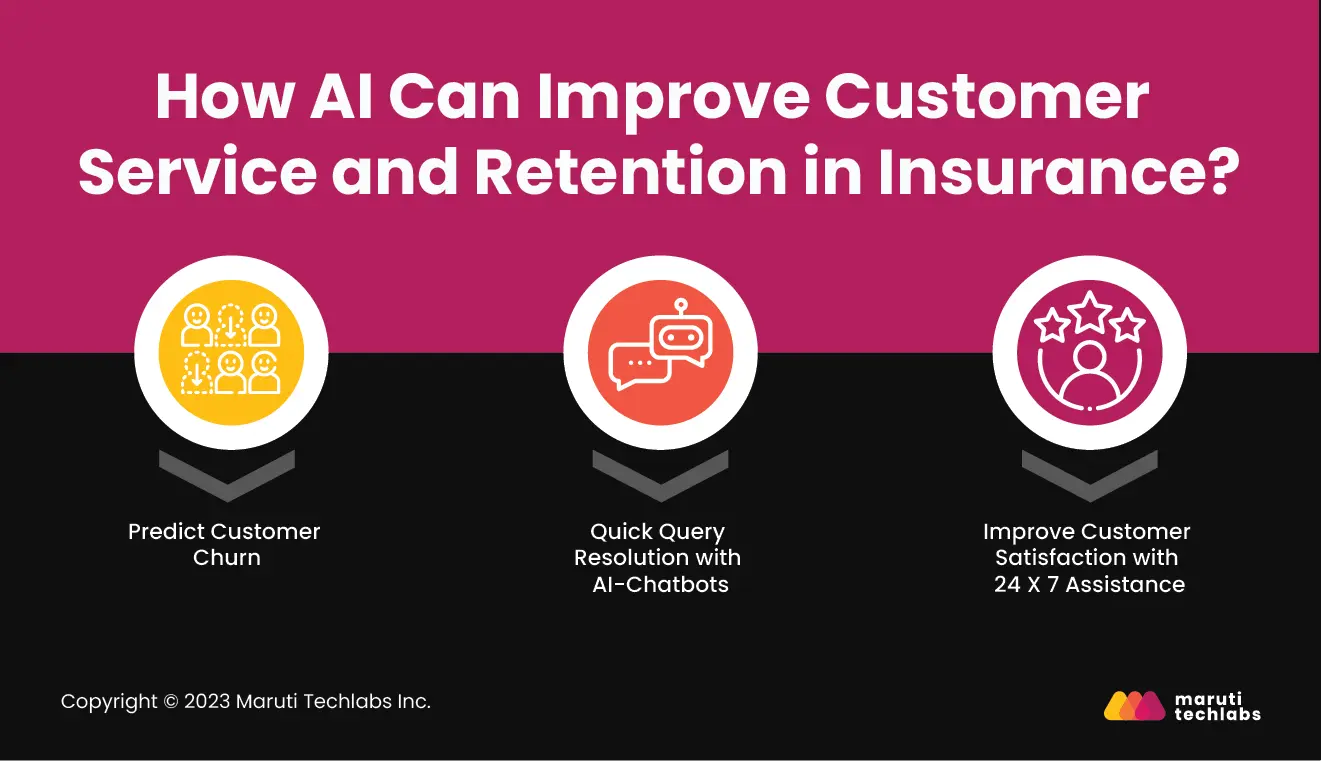
Lemonade, an insurtech startup, leverages AI to undercut more prominent pricing and customer acquisition players. Their enthralling digital experience has made Lemonade a top insurer for younger demographics.
Lemonade's AI claims bot, Jim, adeptly manages many claims and customer queries. In 2019, Jim handled over 20,000 claims and customer queries without human involvement. This has reduced operational costs, streamlined workflow, and elevated customer satisfaction.
The availability of vast datasets, data analytics, and machine learning tools can enable insurers to predict upcoming maintenance. This proactive strategy helps prevent costly breakdowns, reduce downtime, and optimize resource allocation.
For example, AI can predict the maintenance needs of insured properties like houses or cars. It can also flag potential health warnings based on health and wellness data. Ultimately, predictive maintenance reduces the risk of claims and enhances the longevity and reliability of insured assets.
Lucie Bakker, Chief Claims Officer and Board Member at Allianz Versicherungs-AG said, “AI is also helping us to adopt a more predictive and preventive approach – evolving from an insurer who analyzes risks from a rear-view mirror perspective and pays claims to an organization that helps customers to mitigate risks and avoid losses in light of natural catastrophes and related events.”
OCR can accurately capture and reconcile data from diverse sources, thus eliminating the need for manual data entry.
OCR can render each pixel and translate it into digital input when coupled with computer vision. AI tools can then validate the submission against existing database entries. Such enhanced automation can yield significant cost savings.
Additionally, OCR applications can enhance customer onboarding and Know Your Customer (KYC) procedures. Insurers can digitally extract data from ID photos and promptly add it to customer profiles. This enables them to digitally onboard customers while reducing onboarding costs and increasing speed and customer satisfaction.
Telematics devices and smartphone apps enable insurers to closely monitor driving behavior, including speed, braking habits, acceleration, and adherence to traffic rules. This real-time data can also help insurers assist their customers in choosing a less accident-prone or less congested road. This proactive approach minimizes accident risks and dramatically enhances the overall customer experience.
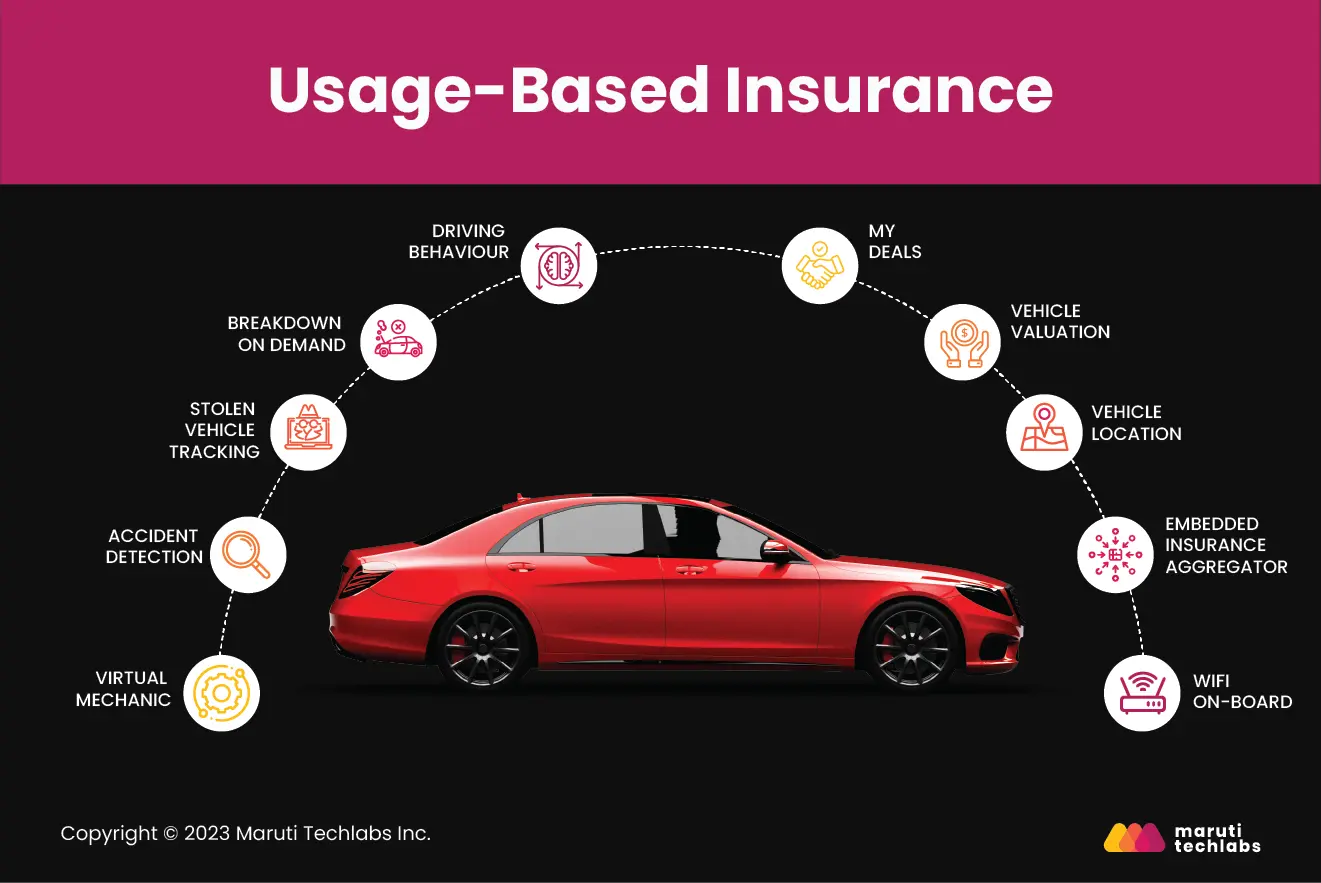
Such insights allow insurers to tailor policies to each driver's risk profile. Safer drivers are rewarded with reduced premiums, while those with riskier habits pay premiums in line with their actual risk exposure. This approach fosters equity and encourages safer driving practices.
Nauto, an AI-enabled driver safety platform, helps predict, prevent, and end distracted driving. The company leverages dual-facing cameras, computer vision, and proprietary algorithms to assess how drivers interact with vehicles and the road to pinpoint and prevent risky behavior in real-time.
Vehicle and asset tracking, when combined with Artificial intelligence, offer a powerful solution for reducing risks and enhancing recovery in theft cases. By integrating GPS, sensors, and machine learning algorithms, this system provides real-time monitoring and analysis of the location of the assets.
Depending on the location and recent happenings in the locality, geospatial analytics platforms and satellite imagery analysis can accurately gauge the risk associated with an asset.
In the event of theft, machine learning models for risk prediction can swiftly detect unusual patterns, such as unauthorized movement or location changes, and trigger immediate alerts to owners and authorities. Such proactive measures increase the likelihood of theft prevention and recovery.
iNetra is an AI-powered system that uses deep learning-based analytics to enhance safety and security in set premises, providing real-time monitoring, instant notifications, and detailed reporting.
AI-driven product innovation is ushering in a new dawn in the insurance industry. By leveraging the power of artificial intelligence, insurers can analyze vast datasets, detect emerging market trends, and gain invaluable insights into ever-evolving customer needs and risks. This data-driven approach paves the way for developing highly customized insurance solutions that cater to the dynamic demands of policyholders.
Predictive models can allow insurers to underwrite entirely new insurance categories. For example, AI can process satellite imagery and weather data to design insurance products tailored to the needs of farmers in regions lacking historical data.
AI-powered dynamic pricing is reshaping the insurance landscape, providing greater fairness and precision in premium determination while accommodating the ever-evolving nature of risk.
Traditionally, companies considered factors like credit score, income, education level, occupation, and marital status to calculate premium pricing. These factors penalized low-income buyers and did not promote fair pricing.
Advanced algorithms and continuous data analysis enable insurers to tailor premium pricing to reflect policyholders' changing circumstances and behaviors. This dynamic model considers various variables, such as driving habits, health data, and environmental factors. It adjusts premiums in real time based on risk factors or individual choices.
For example, accident-prone commuting routes could trigger immediate increases in auto insurance premiums. Likewise, engaging in adventure sports might lead to surges in life insurance costs. Conversely, a commitment to regular workouts could lower health insurance premiums.
Hyper-personalized pricing benefits policyholders by offering equitable pricing and allows insurance companies to stay agile in a rapidly changing world.
Regulatory compliance risk management is a paramount challenge for every insurance company. AI enables insurers to automate complex and labor-intensive compliance monitoring processes.
AI algorithms can swiftly and accurately scan vast amounts of data, pinpointing deviations from regulatory standards. This not only enhances efficiency but also reduces the risk of human errors.
Insurers can promptly identify and address compliance issues, minimizing the potential for fines and legal complications. Moreover, AI-driven compliance checks offer real-time monitoring, allowing insurers to adapt swiftly to evolving regulations, ensuring they remain fully compliant in a rapidly changing regulatory landscape.
Here are the top challenges and risks associated with implementing AI in insurance.
Insurance companies handle sensitive customer data, making privacy compliance critical. Stricter regulations like GDPR and evolving local laws demand secure data handling, transparent consent, and accountability.
Mismanagement can lead to heavy penalties, reputational damage, and loss of customer trust.
Generative AI raises ethical challenges such as misuse in policy communications, synthetic content creation, or decision-making without human oversight.
Insurers must ensure transparency, explainability, and accountability to maintain customer confidence while meeting legal and industry ethical standards.
AI models trained on biased or incomplete datasets may produce discriminatory outcomes in underwriting or claims processing.
These biases undermine fairness, create compliance risks, and erode customer trust. Continuous monitoring and diverse training data are essential to mitigate bias.
AI models and data pipelines are potential targets for cyberattacks, adversarial inputs, or data breaches. Such threats can compromise sensitive customer information and disrupt operations.
Robust security frameworks and ongoing monitoring are crucial to protect systems from emerging vulnerabilities.
Integrating AI with outdated legacy systems presents significant challenges. Compatibility issues, data silos, and infrastructure limitations can slow implementation.
Without modernization and strategic planning, insurers risk underutilizing AI’s potential while incurring higher costs and operational inefficiencies.
The insurance industry is rapidly evolving with AI and generative AI at its core. Over the next few years, these technologies will reshape risk assessment, customer experience, and operational efficiency.
In the next three to five years, AI in insurance will become deeply embedded in every business function. Predictive analytics will drive proactive risk management, claims will be processed in near real time, and customer personalization will reach new levels. AI will shift from support to strategic decision-making.
Generative AI will transform how insurers interact with customers and design products. It will create personalized policy documents, generate dynamic claims reports, and even simulate risk scenarios for better underwriting. Its role will move beyond automation to innovation, allowing insurers to differentiate offerings while improving trust and efficiency.
AI-powered search will enable insurers to instantly retrieve critical data across vast repositories, improving compliance and customer support. Automation opportunities include document processing, fraud detection, and agent assistance. Together, these advancements will streamline back-office functions, reduce operational costs, and empower teams to focus on higher-value decision-making and customer care.
These diverse use cases of AI in insurance serve as a blueprint for insurers to adapt to the ever-evolving environment of the insurance sector. Whether providing tailored product recommendations, predicting claim risk and value, automating insurance workflows, or enhancing customer support, AI is a transformative force.
AI’s versatility holds the potential to revolutionize a multitude of business areas within the insurance industry. Leaders firmly believe that AI can be pivotal in boosting cost savings and business growth. A recent survey highlighted the potential of AI in the insurance space as -
Thus, AI holds the immense power to revolutionize every node of insurance operations, spanning from customer onboarding to policy servicing and claim settlement. If you're still deliberating on how to surf the AI wave and identify the areas where AI can elevate your operations, connect with our experienced AI consultants for strategic insights.
We offer a full suite of AI services catering to the insurance space. We helped one of our clients digitize their entire underwriting process by implementing OCR (Optical Character Recognition) and deep learning technologies. This helped them reduce the time spent on underwriting tasks by 40%, increasing their overall efficiency.
At Maruti Techlabs, we work closely with insurers to help them identify unique opportunities where AI can be applied to enhance customer experiences, streamline operations, and unlock new dimensions of business growth.
Get in touch today!
Generative AI is used to automate policy drafting, create dynamic claims reports, and generate personalized customer communications. It also simulates risk scenarios for underwriting, assists in fraud detection, and enhances chatbots. These applications improve efficiency, cut costs, and deliver tailored experiences that strengthen customer trust and engagement.
Generative AI represents a pivotal part of insurance’s future. It will redefine product innovation, risk modeling, and customer interaction. By generating personalized policies, accelerating claims handling, and predicting risks, it shifts insurers toward proactive, customer-centric models, making AI not just supportive, but central to strategic growth.
Insurers can begin AI adoption by identifying high-impact areas like claims processing, underwriting, and customer service. Starting with pilot projects, ensuring data quality, and integrating scalable AI platforms is key. Partnering with technology providers and fostering a culture of innovation will help accelerate enterprise-wide adoption effectively.

